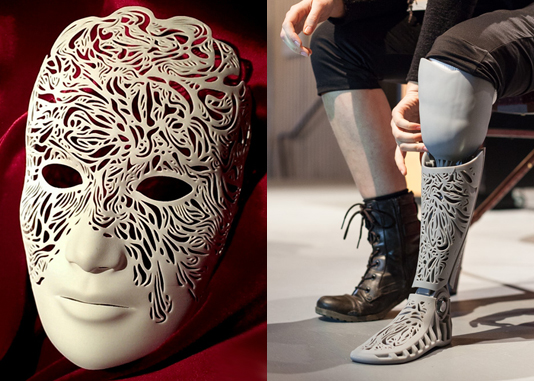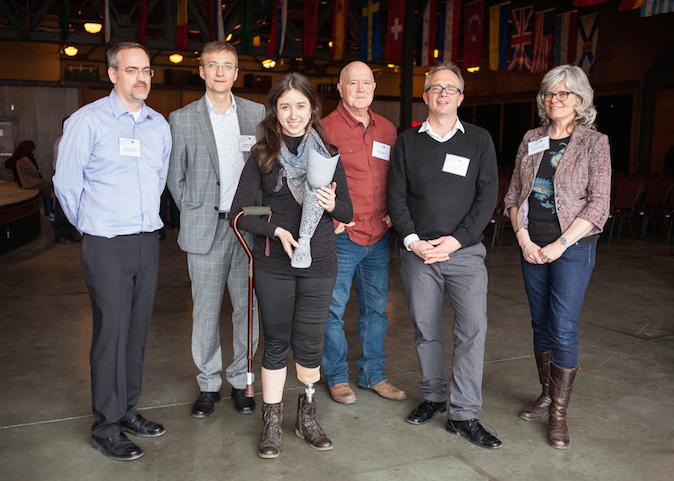
From Eleanor:
I’m very excited to introduce the first of a series of guest blog posts from our Shapeways Crew members. Shapeways Crew are leaders in the field of 3D printing and design and will be sharing their stories, insights, and 3D modeling tips and tricks on the Shapeways blog more regularly. This piece showcases the collaborative nature of the 3D design process and the artistic, creative and therapeutic possibilities 3D printing offers. Melissa Ng is a doodler, entrepreneur, and 3D printing artist who first shared this story on her blog Lumecluster.com.I began my journey in 3D printing back in October 2013. Since then, I’ve been fortunate enough to collaborate with people who constantly push the limits of their expectations and imagination.
In March 2014, one of those amazing people I met was Kendall Joudrie, founder of Truro-based
Thinking Robot Studios. From Kendall, I learned about Natasha Hope-Simpson, a 24-year-old artist and musician who lost her leg in a hit-and-run car collision in her hometown of Wolfville, Nova Scotia.
Despite going through eight surgeries, Natasha’s leg was too mangled to be repaired and she was told that she would never be able to walk properly again. Given these facts, she made the tough decision to amputate her leg.
While Natasha was a victim of a terrible accident, she did not remain a victim of her circumstance. As Haruki Murakami said, “Pain is inevitable. Suffering is optional.”

Although the driver that crushed her leg has still not been found, Natasha told CBC News, “There’s a big part of me that’s forgiven them…holding on to angry feelings prevents you from moving on and I need to move on.”
She chose to discover new possibilities instead of despairing. She chose to see her loss as an opportunity for artistic potential in prosthetics instead of thinking her future is lost. And although her old way of life had been ripped away from her, she chose to believe that she could build a new way of life.
Early in her journey, Natasha spoke to a class at the Nova Scotia College of Art and Design University’s Institute for Applied Creativity (NSCAD), which was the university she had graduated from. She spoke to the class about wanting to design a better prosthetic limb that was both functional and aesthetically pleasing.
That day, NSCAD director, Gregor Ash, happened to be in the audience. Inspired by her speech, Gregor connected Natasha with Kendall Joudrie and Jourdan Dakov of Thinking Robot Studios, who offered to help her engineer a prototype prosthetic in time for
NSCAD Halifax’s first-ever Maker Symposium. And so began Natasha’s beautiful journey down a new road.
While it began with NSCAD and Thinking Robot Studios, Mike Fanning of NovaCad offered to print the prototype. Ian Weir, Department of National Defense, along with Paul Ragot performed a laser scan of her good leg to capture her symmetry. Bob Garrish of Spring Loaded Technology performed a white light scan to aid in design. Finally, Kendall Joudrie and Jourdan Dakov of Thinking Robot Studios consulted with Natasha and engineered a stable prototype. The only thing that was left was aesthetics and there was very little time left before the Halifax Maker Symposium.

Natasha had lots of ideas, but no time. However, she discovered my Dreamer/Nightmare masks on Shapeways and instantly fell in love with them and Kendall Joudrie reached out to me. Needless to say, I was deeply moved by her story and was happy to donate my design to the project. I will continue collaborating with Thinking Robot over the next year as they develop a final prosthetic for Natasha.
Designing and engineering prototypes normally takes many months. But for Natasha’s prosthetic from concept to product? 15 days.
It’s amazing what a single person or a group of people can do when they make something their mission. You know what they say: where there’s a will, there’s a way.
As cliché as this is, it’s true. Yes, your path will always be littered with obstacles, uncertainties, and failures. But it doesn’t mean they have to be feared or disliked every time they enter the picture.
As a designer and artist, I thought about how what can make all the difference is how you consciously decide to respond and react to your experiences. Because when you learn to love the challenge, nothing can stop you from moving forward. Some of life’s most troubling moments often produce the most meaningful experiences, don’t you think? In the end, hardships don’t exist to tear down your hopes and dreams. They serve to make you wiser, stronger, and smarter if you can see the lessons in them.
So, don’t wait for hope. Make your hope.
And show the world what your dreams are made of.







This is a truly inspiring story, thanks for sharing.